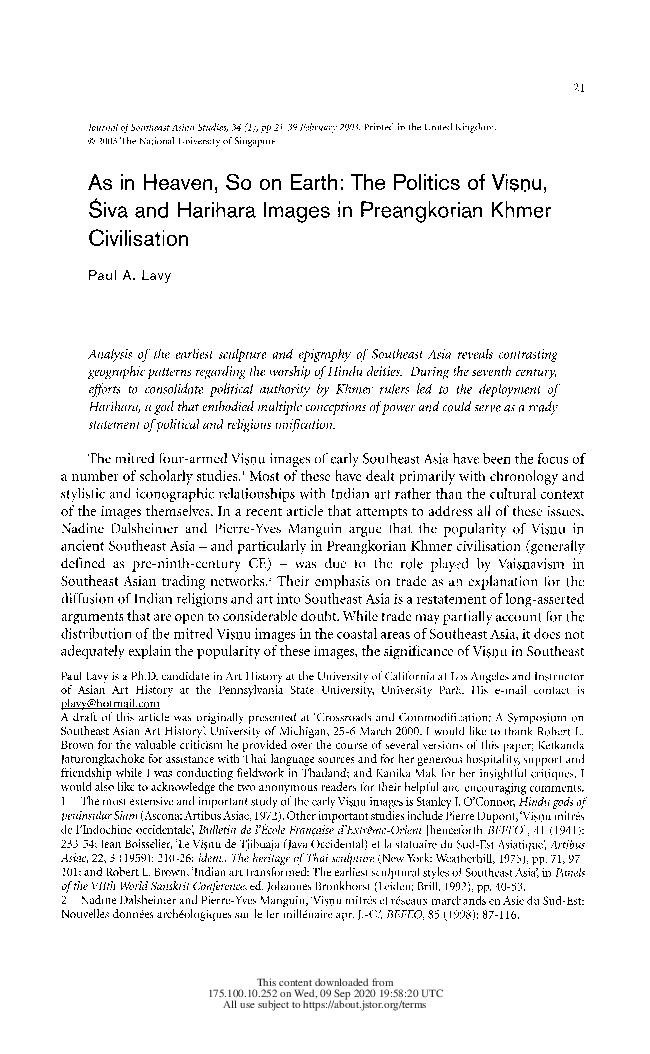As in Heaven, so on Earth: The Politics of Viṣṇu, Śiva and Harihara Images in Preangkorian Khmer Civilisation
by Paul Lavy
The shifting importance of deities in pre-Angkorean Cambodia, and its political meaning.

- Publication
- Journal of Southeast Asian Studies, Vol. 34, No. 1, pp. 21-39 | Cambridge University Press on behalf of Department of History, National University of Singapore
- Published
- February 2003
- Author
- Paul Lavy
- Pages
- 19
- Language
- English
pdf 2.2 MB
This stimulating synthesis on syncretism in pre-Angkorean Khmer space, mostly during the 7th and 8th centuries, show how the mainstream representations of deities slowly shifted from the centrality of Vishnu and Shiva to Harihara’s preeminent images and references.
Notes the author: ‘The sudden interest in Harihara during the middle of the seventh century corresponds to the political interests or, perhaps more accurately, the territorial aspirations of Isanavarman, Bhavavarman II and Jayavarman I, all of whom seem to have maintained similar realms with control strongly held in Kompong Thorn (and Prey Veng) but decreasingly exerted toward the south and southwest where local elites merely evoked [their] suzerainty while maintaining their own local authority’. The distribution of the inscriptions of Isanavarman and Jayavarman indicate, as [Michael] Vickery makes clear, that both rulers endeavoured ‘to maintain administrative control over certain coastal areas which would have been ports of Funan’.’
Furthermore, adds the author, ‘Harihara, then, served as a visual expression of the integration of varying regional styles of rule rooted in the symbolism and power of Siva and Visnu. This would also explain the relatively large numbers of Harihara images that appeared throughout Cambodia during the second half of the seventh century and the first half of the eighth (…) All of this was built on foundations initially laid by Is?navarman and revealed by his extensive building programme and large corpus of inscriptions, both all the more remarkable for being the earliest securely dated Khmer material.’
Photo: A sandstone sculpture of Harihara, ‘the hybrid deity’, from 7th-century Southern Cambodia (MET Collection)
Tags: pre-Angkorean, Harihara, Vishnu, Shiva, Funan, Sambor Prei Kuk, Chenla, syncretism
About the Author

Paul Lavy
An associate professor at University of Hawaii Manoa, Paul A. Lavy received his BA in cultural anthropology and his MA and PhD in South and Southeast Asian art history. He taught ancient art history at Loyola Marymount University, Los Angeles, and Asian and Islamic art history at Pennsylvania State University, University Park.
His ongoing research, which has been funded by the University of Hawaii Research Council, the Metropolitan Museum of Art, the Asian Cultural Council, and the National Security Education Program, investigates the links between art, architecture and political history in early historic Southeast Asia, primarily the Hindu-Buddhist artistic traditions associated with the Mekong Delta and Preangkorian Khmer civilization, and their relationships with the art of South Asia. He is currently researching and writing a book on early sculpture from Thailand, Laos, Cambodia, and Vietnam, The Crowned Gods of Early Southeast Asia.
Publications
[under construction]
‘As in Heaven, So on Earth: The Politics of Visnu, Siva and Harihara Images in Preangkorian Khmer Civilisation’, Journal of Southeast Asian Studies 34 – 1, 2003.

